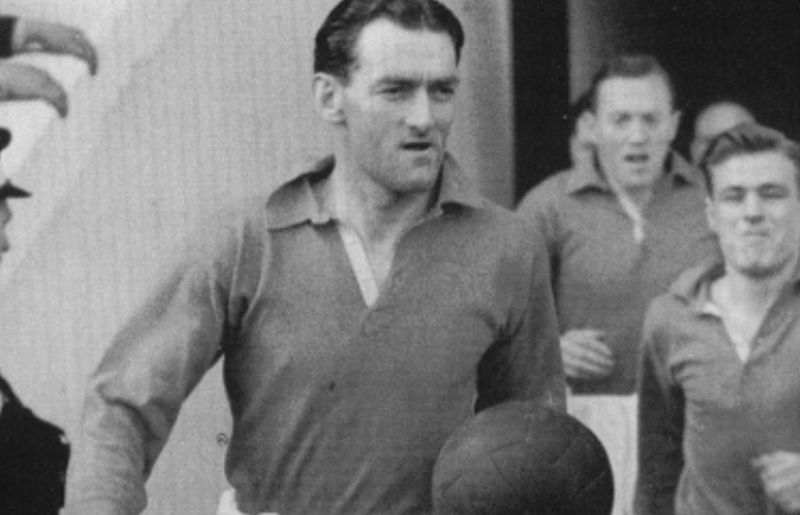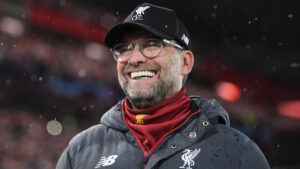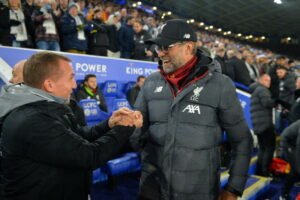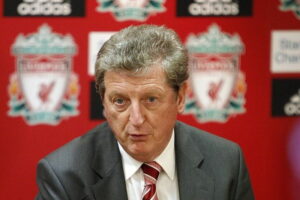
The 1950s were not a good decade for Liverpool Football Club. The decade began with an FA Cup final appearance, but things went down hill from there. Under manager Don Welsh the Reds were relegated out of the top-flight in the same season that Everton were promoted back into it, which obviously stung everyone associated with the club.
Welsh was given time to try to rescue things but failed to do so, meaning that someone else had to be brought in in his place and it was to Phil Taylor that Liverpool turned. Not to be confused with the darts player of the same name, Phil Taylor had been a Liverpool player earlier in his career.
Phil Taylor was 95 when he died on 1 December 2012. He was born in Bristol 18 September 1917 and joined #LFC as a player at a youg age, in March 1936. He played for the Reds until 1954 and in 1956 he became a Liverpool FC manager.
Rest in peace, Phil!#LFChistory_net pic.twitter.com/HjdPkb50gT— LFChistory.net (@LFChistory) December 1, 2022
Maybe the hope was that Taylor would steady the ship, having been part of the backroom staff prior to being offered the manager’s role. If that was the hope then the argument could be made that he succeeded in his aim, keeping the Reds in the top section of the table until he was eventually replaced.
There are many reasons why Taylor’s time in charge of the club might not be remembered, but one of the main ones is unquestionably the person who came after him. Taylor was replaced at the helm by one Bill Shankly, the Scottish manager who would go on to become the founding father of modern day Liverpool. No wonder many don’t know who he was.
The Early Years
Philip Henry Taylor was born in Bristol on the 18th of September 1917, joining his local side of Bristol Rovers as a schoolboy. He became an apprentice at the club and played 21 league matches, scoring two goals. It was a decent enough performance from an inside-forward, catching the attention of the then-Liverpool manager George Patterson.
He cost the club £5,000 and saw Ted Hartill going in the other direction, with the move being completed in March 1936. Later that month, on the 28th, he made his debut in a game at the Baseball Ground, with Taylor scoring a later equaliser in a 2-2 draw with hosts Derby County.
A future #LFC manager Phil Taylor scored an equaliser in the penultimate minute of his Reds debut as Liverpool FC travelled to Derby and drew 2-2.
Taylor had a good career at LFC, playing 343 official games (and winning a league title!) before retiring in 1954.#LFChistory_net pic.twitter.com/HN3dAhsRtk— LFChistory.net (@LFChistory) March 28, 2022
Having joined Liverpool as an inside-forward, Taylor was converted to become a wing-half by George Kay, the man who took over from Patterson as manager at Anfield. It was a position that he made his own, becoming a stylish and composed defender. Kay led Liverpool to the title in the first season after the end of the Second World War, with Taylor playing an important role thanks to 35 appearances and one goal.
It led to an England call-up, with the player appearing for the Three Lions in a British Home Championship match against Wales on the 18th of October 1947, playing alongside the likes of Tom Finney and Tommy Lawton.
Becoming Liverpool Manager
During the 1949-1950 season, Taylor was given the job of captain of Liverpool, appearing seven times for the Reds as the club made its way to the final of the FA Cup. Though he led the team out at Wembley Stadium, he didn’t get to lift the trophy as Arsenal won the game 2-0. He ended his playing career at Anfield having appeared 345 times, scoring 34 goals.
Of those, 312 were in the league, with 32 of the goals coming in league games. As well as being a good footballer, Taylor was also a first-class cricketer, playing a game for Gloucestershire in 1938 and three times for the country’s second eleven, showing his overall sporting ability.
In 1954, he decided that it was time to hang up his boots and stop playing football. He didn’t want to walk away from the club altogether, however, and became part of the backroom staff of Don Welsh. As something of a pre-cursor to what would come later with the Bootroom Boys, Taylor was given the manager’s job in 1956 when Don Welsh had once again failed to get Liverpool out of the Second Division and back into the top-flight.
Welsh had not only taken Liverpool down but also struggled to get the club going, feeling as though an apathetic boardroom didn’t help in his aim of returning the Reds to the top.
Unsuccessful Management
When he took over as manager, Taylor had the aim of putting Liverpool back in the First Division, making the signings of Alan A’Court and Tommy Younger priorities. He also brought in Ronnie Moran. Much like with Welsh, who had signed Geoff Twentyman, Taylor may not have been a massively successful manager but he did bring someone in who would have a huge influence on the club for years to come.
Twentyman, of course, would go on to become one of the club’s most successful ever scouts, whilst Moran would be known as ‘Mr Liverpool’ thanks to his work on the club’s coaching staff for several decades.
Phil Taylor was also the first player to captain a Liverpool team at Wembley – 1950 FA Cup Final. #RIPPHILTAYLOR pic.twitter.com/oBEugQ6G
— Mark Platt (@MarkPlatt73) December 1, 2012
The Reds had finished third in Welsh’s final season, which was seen as being an underachievement. It was hoped that Taylor would be able to push them a step further, especially with Billy Liddell banging in the goals. In the end, though, Liverpool finished third for the second successive season, missing out on the automatic promotion places by a single point.
They were also knocked out of the FA Cup in the third round, meaning that it was an entirely mediocre season given the lofty heights that the Reds had set in the past. Though there was further progress in the FA Cup the following year, making it to the sixth round, they finished fourth in the league.
An End to Management & a Game-Changing Replacement
Phil Taylor had another shot at getting Liverpool promoted. The 1958-1959 campaign was the club’s 67th in existence, with the hope being that two decent finishes would be a good springboard to success. A third round defeat to Worcester City wasn’t a good sign, however.
Worcester City were in the Southern League at time, which was one division below the Football League, so a 2-1 loss to them was seen as somewhat humiliating. In the league, it was a second successive fourth place finish, which many thought should’ve been the end of Taylor’s time in charge of Liverpool, but he kept his job for the start of the following season.
Liverpool FC
Club Legends
Phil Taylor & Bob Paisley pic.twitter.com/XDW0dIyiKM— Superb Footy Pics (@SuperbFootyPics) December 13, 2017
When Liverpool struggled for consistency at the start of the campaign, Taylor came under almost immediate pressure. The Reds failed to win a single game in October, leaving many to question why he was still in his position. A win over Aston Villa at the start of the following month resulted in some thinking that they might be about to turn a corner, but struggling Lincoln City beat the Reds 4-2, resulting in Taylor’s decision to resign.
Liverpool were in 11th place at the time, with Taylor saying, “The strain of trying to win promotion has proved too much.” He spoke to the Liverpool Echo about his disappointment and said:
“No matter how great has been the disappointment of the Directors at our failure to win our way back to the First Division, it has not been greater than mine. I made it my goal. I set my heart on it and strove for it with all the energy I could muster. Such striving has not been enough and now the time has come to hand over to someone else to see if they can do better.”
The person that took over the reigns can very much be considered to have done better. Bill Shankly was appointed as manager on the first of December 1959, with Bob Paisley, the first team trainer, filling in as caretaker manager whilst waiting for Shankly to be appointed. He was in charge for two games, with one of them being a 4-3 win over Leyton Orient and the other a 1-0 loss to Huddersfield Town.
Shankly was the manager of the Hatters at the time, accepting the Liverpool job not long after the match. He took the club to third place that season, but it was what would come in the future that would cement his place as an all-time great.
On this day in 1959 Liverpool manager Phil Taylor resigned, saying “The strain of it all has made me very tired at times and I decided, great as is my love for Liverpool, to resign.”
The best thing about football is that you never know what is going to come next pic.twitter.com/jg84uwlR0w
— The Anfield Wrap (@TheAnfieldWrap) November 17, 2020
For Taylor, his time at Liverpool might well be seen as bittersweet. He was never good enough to get the club promoted or win any silverware, but had he done better then it’s entirely possible that Bill Shankly would’ve taken a job elsewhere and the future of the club might’ve turned out very differently.
Taylor lived to the ripe old age of 95, eventually passing away in December 2012. He served the club loyally from 1936 to 1959, resulting in numerous tributes being paid to him. He is also someone who lifted the lid on life as a manager in the old days, saying in 2003:
“Looking back, one of the biggest differences with today was the position of the manager. At that time, teams at almost all clubs were picked by the board of directors, though they usually did ask the advice of the secretary or coach. I know both Don Welsh and myself had to present our teams to full board meetings, often involving eight or nine directors If you had been winning, the directors were unlikely to object to your team, but it was much harder when you wanted to make changes, and I can remember times when the side that ran out was not really the one I had wanted to play. I was probably not a strong enough personality to be a good manager, because you really need to insist on being in charge if you are going to be successful.”
R.I.P. Phil Taylor. Liverpool's manager pre-Shanks and a fine player for the reds in the Paisley/Liddell/Stubbins era. A real gentleman
— @voiceofanfield (@VoiceOfAnfield) December 3, 2012



